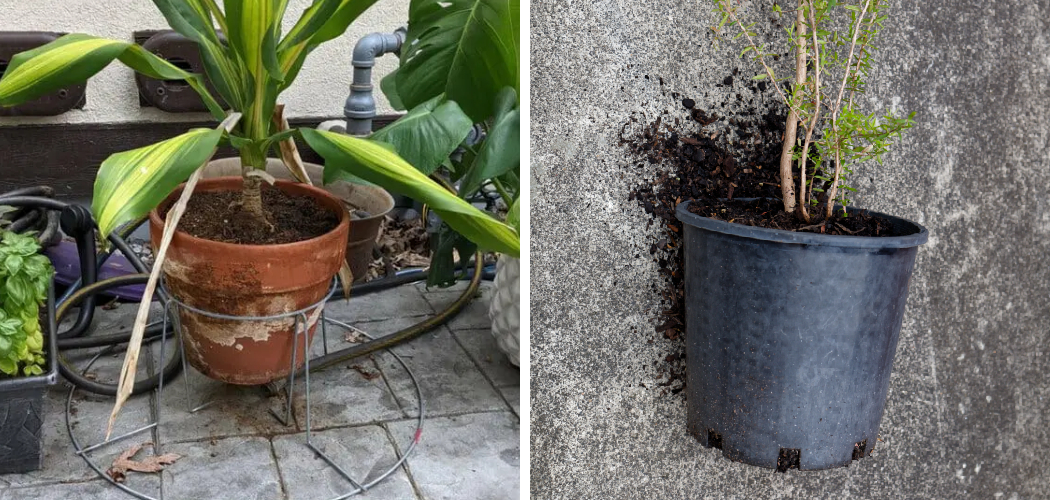To weigh down planters, add weights such as rocks or bricks to the bottom before filling them with soil and plants. This will provide stability and prevent them from tipping over or being blown away by strong winds.
Additionally, choosing heavier planters made of materials like concrete or stone can also help keep them grounded. Adding water to the planters can also increase their weight, but be mindful of overwatering and drainage to avoid damaging the plants. A well-anchored planter ensures the safety and longevity of your plants in various weather conditions, ensuring they thrive and beautify your space.
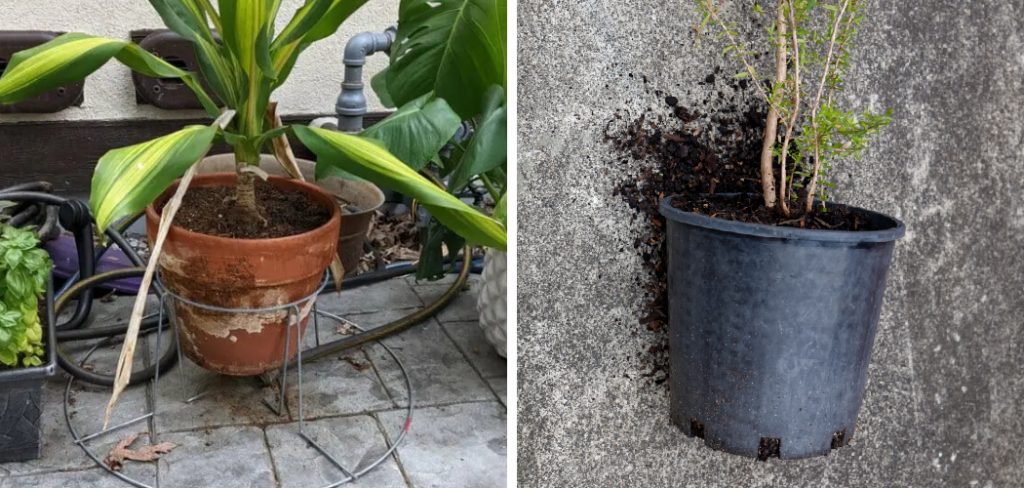
Why Weighing Down Planters Is Important
Weighing down planters is crucial to enhance stability and prevent accidental toppling. This practice also protects plants from wind damage. By adding weight to the planters, you ensure that they remain steady and secure in various weather conditions. This is particularly important for large and tall planters that are susceptible to tipping over.
By keeping the planters stable, you safeguard your plants from potential harm caused by strong winds. Additionally, weighing down planters reduces the risk of accidents, preventing injuries or damages to surrounding objects. This simple yet effective measure can be achieved by adding rocks, sandbags, or even filling the planter with a heavy potting mix.
By prioritizing the stability of your planters, you create an environment that promotes the well-being and longevity of your plants.
Factors To Consider When Weighing Down Planters
Factors to consider when weighing down planters include the size and material of the planters, environmental conditions, and their placement in the surrounding landscape. The size and material of the planters play a crucial role in determining how much weight they can bear.
It’s important to choose planters that are sturdy and made of durable materials. Consider the environmental conditions in your area, such as wind and extreme temperatures, as they can impact the stability of the planters. Additionally, the placement of the planters in relation to the surrounding landscape is important.
Make sure they are positioned on a flat and level surface to prevent any tilting or toppling. By taking these factors into account, you can ensure that your planters are properly weighed down and will stay in place even in challenging conditions.
How to Weigh down Planters: Step by Step Guide
Weighting Options For Planters
Planters can be heavy, and weighing them down is important for stability. One option is to use a soil and gravel combination to add weight. Another method is to add water or sand to the planter, which can easily be adjusted to achieve the desired weight.
Additionally, using decorative stones can not only add weight but also enhance the appearance of the planter. These options provide flexibility and allow you to customize the weight based on your specific needs. Weighing down your planters is crucial to prevent them from tipping over, especially in windy conditions.
So, consider these options to ensure the safety and stability of your plants.
Soil And Gravel Combination
Mixing soil and gravel properly is essential for weighing down planters effectively. The ideal soil to gravel ratio should be maintained to ensure optimal plant growth. While a good combination provides stability, it also allows for proper drainage. The right ratio will prevent waterlogging and root rot, ensuring the health of your plants.
However, it is important to note that there are both benefits and drawbacks to using this mixture. On the positive side, it provides excellent drainage and prevents soil compaction. Additionally, the gravel helps to distribute the weight evenly, reducing the risk of the planter tipping over.
However, one drawback is that the gravel can sometimes be difficult to mix evenly with the soil. Despite this, mastering the right soil and gravel combination will enhance the stability and overall appearance of your planters.
Adding Water Or Sand
To weigh down planters, one effective method is to add water or sand. The amount of water or sand you use depends on your plant’s needs. It is crucial to ensure proper drainage to prevent water stagnation. Adding water can provide temporary weight, but it requires regular monitoring and replenishment.
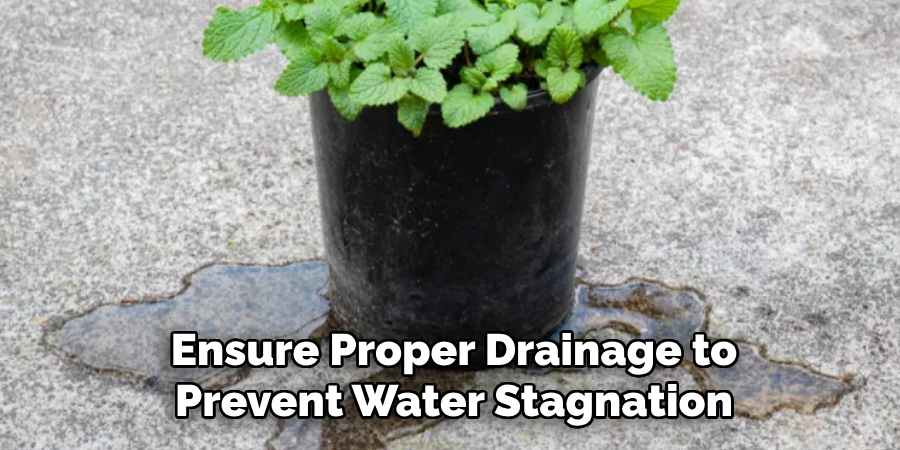
On the other hand, sand provides long-term stability but can limit drainage if not properly managed. Both methods have advantages and disadvantages. Water is easily accessible and adjustable, but it can become a breeding ground for mosquitoes. Sand, on the other hand, offers stability and doesn’t require constant attention, but it can be challenging to adjust the planter’s weight once added.
Consider these factors when determining the best option for weighing down your planters.
Using Decorative Stones
Using decorative stones is a great way to weigh down planters effectively. When choosing the right type of stones, consider their weight and size. Arrange the stones within the planter strategically to ensure optimal weight distribution. This will help keep the planter stable and prevent it from toppling over.
On the one hand, using decorative stones can provide a visually appealing element to your planters. On the other hand, there are some drawbacks. The weight of the stones may make it more difficult to move or reposition the planters.
Additionally, certain types of stones may be more expensive or harder to find. Nevertheless, weighing down planters with decorative stones offers stability and aesthetic benefits.
Diy Techniques For Weighing Down Planters
Looking to weigh down your planters? Here are some diy techniques you can try. One option is to repurpose everyday objects to add weight to your planters. Reinforcing the bases of your planters can also help keep them stable. Consider using materials such as rocks, pebbles, or sand to create a hidden weight chamber within your planters.
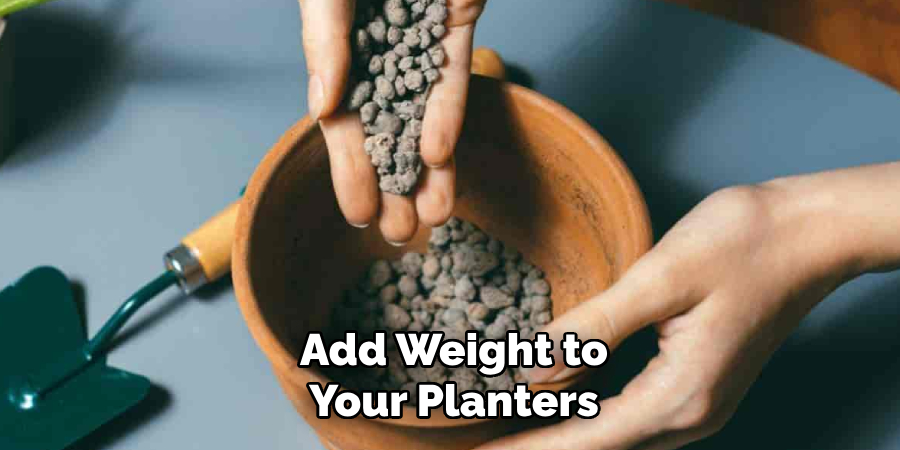
By distributing the weight evenly, you can prevent your planters from tipping over or getting blown away by wind. These simple tips can help ensure the stability of your planters and keep your plants safe and secure. So, go ahead and give these techniques a try to weigh down your planters effectively.
Repurposing Everyday Objects
Repurposing everyday objects to weigh down planters can be an effective solution. Using bricks or concrete blocks is a popular method for stabilizing outdoor containers. Incorporating old dumbbells or weights can also provide the necessary bulk. Another option is to utilize heavy books or magazines to add weight and keep the planters in place.
These items can be easily found around the house and repurposed for this specific task. By repurposing everyday objects, you can save money and repurpose items that might have otherwise gone to waste. This simple solution allows you to enjoy your plants without worrying about them getting tipped over by strong winds or top-heavy growth.
Reinforcing Planter Bases
Planters can be reinforced by adding reinforcement plates or braces, which provide extra stability and support. Another option is to attach styrofoam support to the base of the planter, effectively reducing the overall weight. Applying epoxy or adhesive to the base of the planter can also enhance its sturdiness.
These methods ensure that the planter remains balanced and can withstand the weight of the soil and plants. Whether you choose to reinforce with plates or braces, use styrofoam support, or apply epoxy, these techniques will help weigh down your planters and prevent them from toppling over.
Creating A Hidden Weight Chamber
Creating a hidden weight chamber is a clever solution to weighing down planters. One way to do this is by constructing a removable false bottom. This allows you to install a secret compartment for weights, which can be easily adjusted as needed.
By concealing this compartment with plants or decorative coverings, you achieve a seamless and aesthetically pleasing look. This technique ensures that your planters remain stable and steady, even in windy conditions or when filled with heavy soil. With a well-designed hidden weight chamber, you can enjoy the beauty of your plants without worrying about them tipping over or becoming unbalanced.
Take the time to carefully plan and implement this technique to enhance the stability and durability of your planters.
Professional Tools For Weighing Down Planters
Planters can be easily weighed down using professional tools. One effective method is incorporating metal reinforcements, such as rods or wire mesh, into the planter structure. This provides additional stability and prevents the planter from tipping over. Another option is to use concrete mix or cement to add weight to the planter.
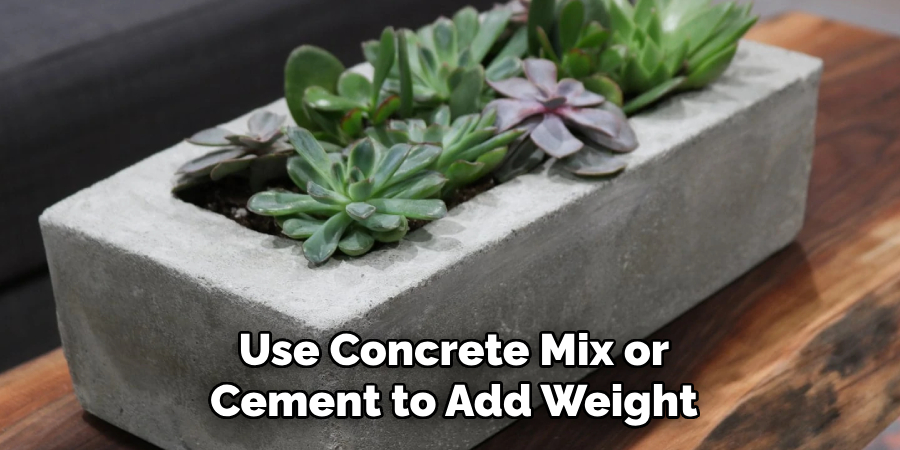
By filling the planter with a mixture of concrete and water, it becomes heavier and more stable. Additionally, installing anchoring systems can further secure the planter to the ground or nearby structures, preventing it from being affected by strong winds or accidental bumps.
These methods ensure that your planters remain securely in place, allowing your plants to thrive without any worries. So, make use of these professional tools to weigh down your planters effectively.
Usage Of Concrete Mix Or Cement
A proper concrete mix or cement can be used to weigh down planters effectively. Preparation of the right concrete mix involves understanding the ideal ratio of cement to sand and aggregate. Molding techniques play a vital role in shaping the planter structure, while curing techniques ensure its strength and durability.
Using a concrete mix offers several advantages, such as weather resistance and longevity. However, it also has its limitations, such as the weight of the planter and the need for expertise in handling. Considering these aspects is crucial when deciding to use concrete mix or cement to weigh down planters.
Incorporating Metal Reinforcements
Incorporating metal reinforcements is a practical solution for weighing down planters. Adding rebar or steel mesh can provide the necessary support to prevent tipping or toppling. Securing these metal supports to the planter ensures stability, especially in windy conditions or with heavy plant growth.
The benefits of using metal reinforcements include enhanced durability and longevity of the planter, as well as minimizing the risk of accidents that can damage plants or surrounding areas. However, it’s important to consider the limitations of this method too.
The added weight may make the planter more difficult to move or reposition, and the metal reinforcements may also affect the aesthetics of the planter. By carefully weighing the benefits and limitations, gardeners can make an informed decision on whether to incorporate metal reinforcements into their planters.
Installing Anchoring Systems
Installing anchoring systems is crucial for weighing down planters, providing stability and preventing accidents. One effective method is utilizing screw-in ground anchors, which securely hold the planters in place. These anchors twist into the ground, providing a solid foundation that anchors the planter securely.
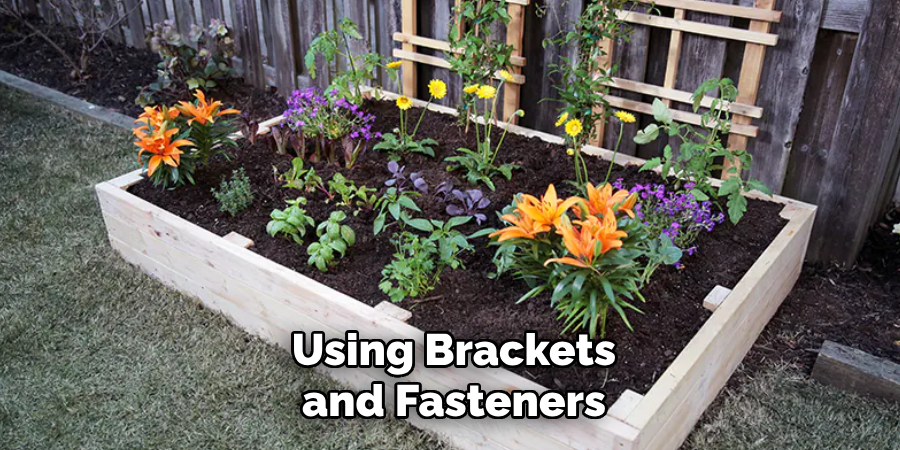
Another option is using brackets and fasteners, which can be attached to walls or other structures to support the planters. For larger planters, tension systems can be used to distribute the weight evenly and ensure stability. These systems utilize cables or rods that are tensioned to hold the planters securely in place.
By implementing these anchoring methods, you can ensure that your planters stay put, even in inclement weather or high winds, providing a safe and attractive outdoor display.
Maintenance And Considerations For Weighed-Down Planters
Regular inspection and adjustment of weighed-down planters is crucial for their maintenance and longevity. Adequate watering and proper drainage need to be considered to avoid any damage to the plants. Assessing the weight requirements periodically ensures that the planters remain stable and secure.
Checking for any signs of cracking or weakening is essential to prevent accidents or mishaps. By examining the planters on a regular basis, any necessary adjustments can be made promptly to ensure their stability and prevent any potential damage. The weight of the planters should be adjusted accordingly, depending on factors such as the size and type of plants being grown.
Proper maintenance and considerations for weighed-down planters are vital for a successful gardening experience.
Frequently Asked Questions On How To Weigh Down Planters
How Can I Weigh Down My Planters?
You can weigh down your planters by adding heavy objects like rocks or bricks to the bottom of the pots. This will provide stability to the planters and prevent them from tipping over during strong winds or storms.
What Are The Benefits Of Weighing Down Planters?
Weighing down planters prevents them from getting knocked over by wind or animals, ensuring the safety of your plants. Additionally, it adds stability to the containers, which helps to keep the soil and plants in place. This can be particularly useful for large or top-heavy planters.
Can I Use Water To Weigh Down My Planters?
Yes, using water to weigh down your planters is an effective option. However, keep in mind that you will need to drain the water properly and regularly to prevent overwatering of your plants. Also, remember that water can freeze in colder climates, so consider using other methods during winter months.
Are There Any Decorative Ways To Weigh Down Planters?
Yes, there are several decorative ways to weigh down planters. You can use decorative stones, pebbles, or decorative balls made of materials like ceramic or glass. These decorative objects not only add weight but also enhance the aesthetic appeal of your planters.
How Much Weight Should I Add To My Planters?
The amount of weight you should add to your planters depends on their size and height. As a general guideline, aim to add around 10-20% of the planter’s total weight in additional weight. Start with a smaller amount and adjust as needed to ensure stability without overwhelming the planter’s structure.
Can I Use Sand To Weigh Down My Planters?
Yes, sand can be used to weigh down planters effectively. It provides stable weight while also allowing for proper drainage. Fill the bottom of the planter with sand, leaving enough space for the plant’s roots and soil. This method works well for both indoor and outdoor planters.
Conclusion
Weighing down planters is crucial for maintaining the stability and longevity of your plants’ containers. By following a few simple steps, you can ensure that your planters stay in place and your plants thrive. First, choose a suitable material for weighing down the planter, such as rocks or sand.
This will provide the necessary stability to prevent the planter from tipping over in windy conditions. Next, ensure that the planter is properly balanced by distributing the weight evenly throughout the container. This will help to avoid any strain on the structure and prevent potential damage.
Finally, regularly inspect and maintain your planters to ensure that they remain stable and in good condition. By taking these steps, you can enjoy the beauty of your plants without worrying about the safety and stability of your planters.

